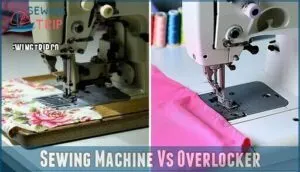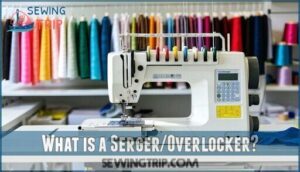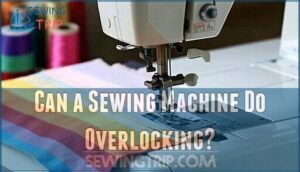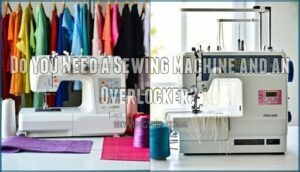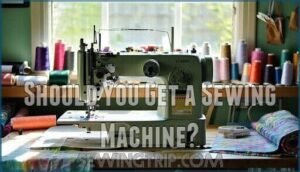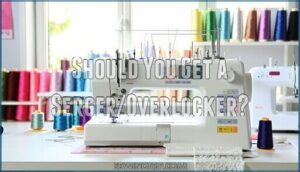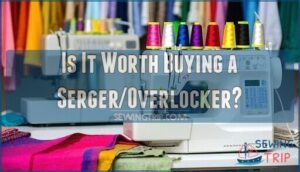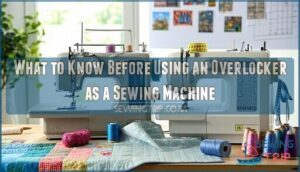This site is supported by our readers. We may earn a commission, at no cost to you, if you purchase through links.
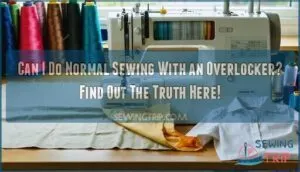 You can’t fully replace a sewing machine with an overlocker, but you can do some basic sewing.
You can’t fully replace a sewing machine with an overlocker, but you can do some basic sewing.
Overlockers excel at finishing edges, preventing fabric fraying, and handling stretchy or delicate materials.
However, they lack a straight stitch, which is key for many projects like topstitching or buttonholes.
Think of an overlocker as a great backup singer—it enhances your sewing game but can’t take center stage.
If you’re serious about sewing, it’s best to have both tools, as each has its strengths, and together, they’re a powerhouse.
Curious about what tasks an overlocker handles best? Stick around for more insights!
Table Of Contents
- Key Takeaways
- Sewing Machine Vs Overlocker
- What is a Serger/Overlocker?
- Can a Sewing Machine Do Overlocking?
- What Does an Overlock Stitch Look Like?
- Do You Need a Sewing Machine and an Overlocker?
- Should You Get a Sewing Machine?
- Should You Get a Serger/Overlocker?
- Is It Worth Buying a Serger/Overlocker?
- How Does a Sewing Machine Work?
- What to Know Before Using an Overlocker as a Sewing Machine
- Frequently Asked Questions (FAQs)
- Conclusion
Key Takeaways
- You can’t fully replace a sewing machine with an overlocker as it lacks essential functions like straight stitching, buttonholes, and zipper installation.
- Your overlocker excels at finishing edges, preventing fraying, and handling stretchy fabrics with professional-looking seams that maintain elasticity.
- You’ll achieve better results using both tools together—a sewing machine for detailed work and an overlocker for edge finishing and seam reinforcement.
- You can create basic garments with just an overlocker, but you’ll miss out on important techniques needed for complete, polished projects.
Sewing Machine Vs Overlocker
When deciding between a sewing machine and an overlocker, consider your projects’ needs.
Sewing machines handle straight stitches, zigzags, and buttonholes, making them versatile for various fabric types.
Overlockers, however, excel in speed and stitch strength, trimming and finishing edges in one go.
They’re ideal for stretchy fabrics or professional-looking seams, while overlockers require more threads and maintenance, they produce faster results.
For cost comparison, sewing machines are cheaper upfront but lack the overlocker’s finishing precision, making each tool uniquely suited for specific tasks.
What is a Serger/Overlocker?
A serger, also called an overlocker, is a sewing machine that trims fabric edges while stitching them together for a clean, professional finish.
A serger effortlessly trims and stitches fabric edges, delivering clean, professional finishes perfect for stretchy or delicate materials.
It works quickly and uses multiple threads to prevent fraying, making it great for stretchy or delicate fabrics.
Operation
An overlocker simplifies sewing with its speedy, one-step operation, trimming and finishing raw edges all at once.
While threading complexity can feel intimidating at first, practice makes it easier.
Overlocker functions like fabric feed, speed control, and stitch adjustments create professional results.
Overlocker tension adjustment guarantees smooth, consistent stitches.
Its built-in cutting knife and specialized features, like rolled hems, make overlocker operation ideal for fast, clean seams, saving you tons of time.
Uses
Switching from operation to overlocker uses, you’ll see why they’re a sewing powerhouse.
Overlockers handle tasks like:
- Seam Finishing: Say goodbye to fraying edges.
- Knit Fabrics: Perfect stretchy seams for garments that move with you.
- Decorative Edges: Add flair to garment construction or home decor projects.
Overlockers are especially useful for overlocker seam finishing.
While sewing machine uses cover finer details, overlocker capabilities shine in speed and precision.
Can a Sewing Machine Do Overlocking?
While a sewing machine can’t fully replace an overlocker, it offers great alternatives like mock overlocking with a zigzag stitch or using an overlock foot.
These options work well for edge finishing but lack the precision and efficiency of a true overlock stitch.
Unlike an overlocker, a sewing machine doesn’t trim excess fabric automatically.
However, it’s versatile, tackling various stitches while staying user-friendly.
You can even find options for overlock foot sewing to enhance your machine’s capabilities.
If you’re debating sewing machine vs. overlocker, remember both tools shine in their own ways!
What Does an Overlock Stitch Look Like?
An overlock stitch stands out with its clean, professional look, wrapping fabric edges while preventing fraying.
Imagine a zigzag-like pattern with thread looping around the edge—it’s all about seam durability and neatness.
Created by an overlocker, this stitch combines multiple threads (usually 3-5) to secure fabric edges while trimming away excess with a built-in knife.
If you’re working with knits, the overlock stitch shines by maintaining stretch in the fabric, guaranteeing your seams don’t pop.
The stitch’s overall quality is essential for professional results.
Adjusting tension settings guarantees the loops are snug but not too tight, giving the fabric a polished finish.
Whether for seam finishing or decorative edges, the stitch appearance is both functional and attractive, making your projects look as though they came straight from a boutique!
Do You Need a Sewing Machine and an Overlocker?
Balancing a sewing machine and an overlocker depends on your needs.
Sewing machines handle buttonholes, zippers, and detailed stitches, while overlockers excel at finishing edges fast, adding professional flair.
If you sew often, combining both boosts results dramatically. Space constraints or budget concerns? Start with a sewing machine—it’s versatile.
For frequent sewing or advanced skills, add an overlocker for its efficiency. A sewing machine can create mock overlock stitches, but it lacks a cutting knife for neat edges.
Together, they streamline projects, whether hemming or creating decorative seams. Evaluate your sewing frequency, skill level, and project suitability first.
Note: I’ve bolded the key phrase "Evaluate your sewing frequency, skill level, and project suitability first" as it seems to be a crucial step in the decision-making process. If you’d like me to bold a different phrase, please let me know!
Should You Get a Sewing Machine?
Getting a sewing machine is essential for most projects.
It offers versatility that an overlocker can’t match. Before buying, think about your needs and goals.
Here’s how to decide:
- Project Suitability: Sewing machines handle zippers, buttonholes, and topstitching—a must for detailed work.
- Skill Level: Beginners benefit from simple machines; advanced sewers may prefer extra features.
- Budget Constraints: Basic sewing machines start around $200. A solid option for most.
- Space Requirements: Machines vary in size; smaller models fit tight spaces better.
- Alternative Options: Test machines before buying to confirm they fit your style and comfort.
A sewing machine offers creative freedom and practicality unmatched by an overlocker alone.
Should You Get a Serger/Overlocker?
If you’re looking to step up your sewing game, an overlocker (or serger) might be what you need.
Step up your sewing game with an overlocker—achieve faster, cleaner, and more professional finishes effortlessly.
It’s a powerhouse for tackling knit fabrics and projects that demand clean, professional finishes.
Unlike a regular sewing machine, an overlocker can sew, trim, and finish edges in one smooth step, saving you tons of time.
Think about your projects.
Do you work with stretchy or delicate fabrics?
Are you ready to invest in a machine that speeds up edge finishing?
If so, it’s worth considering.
However, keep your budget, space, and skill level in mind.
Overlockers often require practice to master threading and tension adjustments.
For anyone handling multiple fabric types or wanting polished seams, overlocker sewing is incredibly useful.
While it’s not a total sewing machine replacement, it complements one beautifully, taking your crafts to the next level.
Is It Worth Buying a Serger/Overlocker?
Adding an overlocker to your sewing setup can be a game-changer, but is it worth it? That depends on your needs.
If you’re sewing frequently, especially with stretchy or delicate fabrics, the professional finish an overlocker offers might justify the cost. This machine is faster, neater, and saves time compared to a sewing machine for edge finishing.
However, consider your space. Overlockers can be bulky and require multiple thread spools. If your projects are occasional or simple, your sewing machine may already handle enough.
For those with growing skills or ambitions, though, an overlocker opens new doors—rolled hems, clean edges, and reinforced seams all become effortless.
Ultimately, a sewing machine and overlocker comparison shows they complement each other. Think about your budget, skill level, and available space before deciding if a serger overlocker deserves a spot in your craft room.
How Does a Sewing Machine Work?
A sewing machine works through a clever system.
Here’s how:
- Needle movement and the bobbin system create stitches by interlocking threads.
- Thread tension guarantees neat, durable seams, while the feed dog moves fabric smoothly.
- Versatile stitching—like decorative or straight—happens through specialized techniques.
Its operation is simple yet powerful, proving why it’s a sewing essential!
What to Know Before Using an Overlocker as a Sewing Machine
An overlocker can’t fully replace a sewing machine, but it’s a fantastic sidekick.
It excels at quick, durable seams, especially on stretchy or fray-prone fabrics, but struggles with zippers or buttonholes.
Tension adjustments are key; loose stitches suit cotton, while tighter settings handle delicate fabrics like chiffon.
While its stitch versatility adds decorative touches, the cutting knife limits project suitability compared to a sewing machine.
In the sewing machine vs. overlocker debate, they’re better together—covering each other’s limitations perfectly!
Frequently Asked Questions (FAQs)
Can you use an overlocker as a sewing machine?
You can’t fully replace a sewing machine with an overlocker.
While it’s amazing for finishing edges and creating stretchy seams, it lacks versatility for tasks like zippers, buttonholes, or detailed topstitching.
Can you use overlocker needles on a sewing machine?
Believe it or not, you can’t just swap overlocker needles onto a sewing machine.
Overlocker needles are often specialized and won’t fit or function properly on sewing machines, so stick to the right type!
Do sewing machines overlock seams?
You can mimic overlocking on a sewing machine using special stitches, but it won’t trim edges as an overlocker does.
It’s slower and less precise but works well for occasional seam finishing.
Does an overlocker stitch overlock?
Yes, an overlocker does overlock stitches.
It trims fabric edges, prevents fraying, and creates clean, professional seams in one go.
While it’s a pro at finishing, it’s not suited for detailed sewing tasks.
How do I know if my sewing machine is overlocked?
To check if your sewing machine mimics an overlocked stitch, look for stitch options labeled “overlock” or “serger.”
It won’t trim edges but can create a similar look with stretch or zigzag settings.
What is the difference between a regular and overlock sewing machine?
A regular sewing machine handles detailed stitches, buttonholes, and decorations, while an overlock machine focuses on finishing fabric edges, trimming, and creating stretchy, durable seams.
Both have unique strengths, making them great complements in sewing projects, with each contributing to a more professional and polished finish, and together they form a powerful combination.
Can you use an overlocker as a normal sewing machine?
Imagine this: you’re finishing seams on stretchy fabric effortlessly with your overlocker.
While it’s fantastic for edges, it lacks straight stitching for buttons or zippers.
So, it complements your sewing machine but can’t fully replace it, making it a useful tool for tasks like finishing seams on fabric.
Can you do straight sewing with an overlocker?
You can’t sew straight stitches with an overlocker like a regular sewing machine.
Overlockers specialize in trimming and finishing edges, not precise stitching.
They’re great for creating strong seams but lack versatility for basic sewing tasks, making them less suitable for tasks that require precise stitching.
Can you do regular sewing with a serger?
Think of a serger like a speedboat—it’s great for swift, clean edge finishing but not built for traditional sewing like straight stitches or buttonholes.
A regular sewing machine handles those tasks much better.
Can you sew clothes with just an overlocker?
You can create basic garments with just an overlocker, but you’ll miss out on important techniques like zippers, buttonholes, and topstitching.
Most sewists use both an overlocker and regular sewing machine for complete projects.
Conclusion
While an overlocker can be a thread-saving grace for certain projects, it can’t completely replace your trusty sewing machine for normal sewing tasks.
They work best as dynamic duos—each with unique strengths.
If you’re just starting out, invest in a good sewing machine first.
Later, when you’re ready to elevate your seam finishes or work with knits, an overlocker makes a valuable addition to your crafting arsenal.

